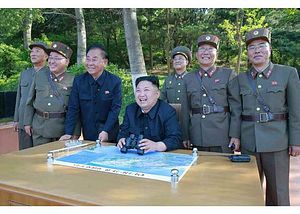North Korean state media closed out the month of November with a broadside against Japanese Prime Minister Shinzo Abe. An article attributed to a deputy director-general for Japanese affairs of the Ministry of Foreign Affairs of the Democratic People’s Republic of Korea (DPRK) — North Korea’s formal name — took aim at Abe, calling him a “matchlessly political dwarf.”
These types of articles lashing out at Abe and Japan have been common since the start of inter-Korean and U.S.-North Korea diplomacy in early 2018. Japan has largely stepped in as the main target of North Korean complaints. The latest article, which was dispatched via the Korean Central News Agency, put in focus North Korea‘s latest test of the KN25 multiple launch rocket system.
“On November 28 when the volley test-fire of the super-large multiple launch rocket system of the DPRK was conducted successfully amid great satisfaction, Abe convened an emergency meeting of the National Security Council and claimed that it was a ballistic missile launch and grave challenge to the international community with no reason,” the article noted.
The article bristled at the characterization by the Japanese government of the test as a “ballistic missile launch.” Earlier this year, Pyongyang reacted similarly when the United Nations Security Council met in New York to discuss its missile launch activity after it tested a “large-caliber” MLRS. Evidently, North Korea seeks to distinguish its MLRS systems from ballistic missiles, but the difference is largely semantic.
The distinction matters for sanctions reasons. Under United Nations Security Council resolution 1718, North Korea is barred from launching any ballistic missiles. Even though Pyongyang rejects the validity of the sanctions regime in its entirety, it seeks to underscore that these systems are not ballistic missiles.
“Abe would be well-advised to distinguish multiple launch rocket from a ballistic missile,” the North Korean article noted.
My view is that there‘s very little that would meaningfully distinguish the approximately 600 mm diameter KN25 multiple launch rocket system from a “ballistic missile.” Indeed, recognizing the fungibility of the term “ballistic missile” and “rocket,” the U.S. intelligence community uses the term close-range ballistic missile to describe many shorter-range MLRS systems. Ultimately, with guidance, canard fins, and a new solid propellant booster, the development and testing of the KN25 certainly violates the spirit of the language in resolution 1718.
The North Korean article also suggests that Japan may see new launches soon — possibly into its exclusive economic zone. “Abe may see what a real ballistic missile is in the not distant future and under his nose,” the article warned. Earlier this fall, in October, the Pukguksong-3 submarine-launched ballistic missile became the first North Korean ballistic missile since the November 2017 launch of the Hwasong-15 to land in Japan’s EEZ.
Pyongyang’s warning should be taken seriously particularly in light of the fact that Kim Jong Un’s deadline for diplomacy with the United States is quickly approaching. Once 2020 opens, North Korea may return to launching longer-range missiles of the kind that it has abstained from testing under a self-proclaimed moratorium. Some of these missiles may land in the waters near Japan, as they did back in 2017.
Under some circumstances, North Korea may also return to launching missiles over Japan to validate reentry vehicles over more realistic trajectories, or possibly even conduct a new type of space launch that would see a space launch vehicle launched over Japanese territory too.
In August and September 2017, North Korea launched two Hwasong-12 intermediate-range ballistic missiles over Japanese territory. Before it did so, it released a summer statement remarkably similar in tone to the language of the latest broadside against Japan. On June 2, KCNA ran an article attributed to a Foreign Ministry spokesman saying that Japan “is now not entitled to fault the DPRK, no matter what it launches or whether that crosses the sky above Japan.” (That article followed a satellite launch by Japan.)

































